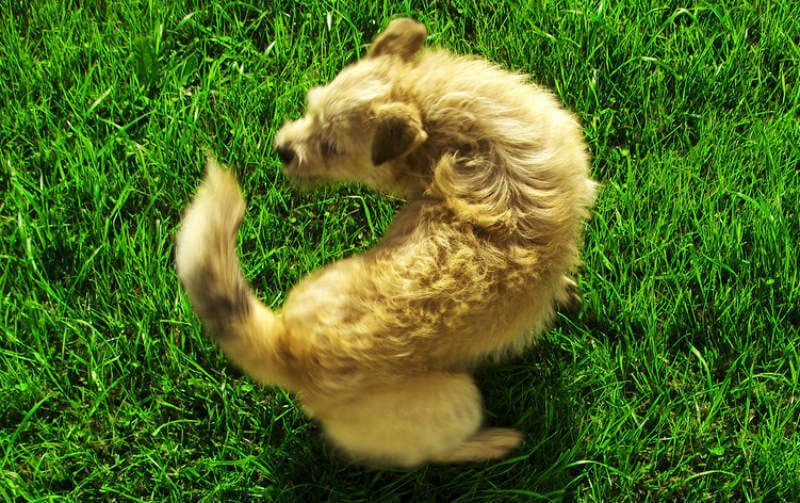Dogs, those lovable furballs, often entertain us with their quirky behaviors. One such act that captivates both pet owners and onlookers alike is the age-old phenomenon of tail chasing. In the rhythmic dance of a dog chasing its own tail lies a mystery that goes beyond mere playfulness. This exploration aims to decode the enigma of why dogs do chase their tails.

Beyond the surface-level amusement,
we delve into the behavioral, psychological,
and physiological aspects that underpin this fascinating dog activity.
REASONS BEHIND WHY DOGS CHASE THEIR TAILS
In the whimsical world of dog antics, few behaviors captivate our hearts as much as the timeless act of tail chasing. Picture a joyful pup in a dizzying dance, and you’re witnessing a spectacle that’s both amusing and mysterious. This deep dive into why dogs chase their tails explores the spectrum of reasons behind this seemingly playful yet enigmatic behavior. From the playful pup’s whirl to the occasional tail pursuit in older dogs, we untangle the threads that make up this charming canine ballet.
The Playful Pup Perspective
Puppyhood, a time of boundless energy and curiosity, often sees tail chasing as an expression of playfulness. As pups discover the joy of movement, the delightful twirl becomes a language of exuberance. Tail chasing is often associated with playfulness, a whimsical expression of a dog’s boundless energy and joy.
Communication through Movement – The Quest for Attention
Dog communication relies heavily on body language, and tail chasing, when not purely playful, can be a form of non-verbal expression. Dogs convey emotions and intentions through this delightful dance.
For some dogs, tail chasing becomes a performance to garner attention. Tail chasing, at times, is an expression of excitement. Whether anticipating a favorite activity or the arrival of a beloved human, dogs convey their enthusiasm through this joyful whirl.
Tail chasing can be a strategy for garnering attention. Social creatures, dogs may engage in this behavior to captivate the focus of their human companions, seeking interaction. Curiosity, a driving force behind tail chasing, stems from a pup’s quest to understand its body and surroundings. Tail chasing becomes a form of exploration, a dance of self-discovery. Tail chasing often emerges when dogs are left alone or feel bored. It becomes a self-entertainment mechanism, a way to alleviate loneliness or pass the time.
Physical Discomfort and Health Factors
Physical discomfort, especially itching due to fleas or other skin irritations, may prompt tail chasing. Dogs attempt to alleviate discomfort through this behavior, highlighting the importance of addressing skin issues. Issues with anal glands can lead to discomfort, driving tail chasing as a coping mechanism. Regular veterinary checks are crucial for maintaining gland health and preventing associated behaviors. In older dogs, tail chasing might be linked to orthopedic pain. Understanding this connection emphasizes the need for senior dog care, including pain management and joint health.
Obsessive-Compulsive Behavior
Tail chasing can take an obsessive turn, signifying compulsive behavior. This section explores the concept of obsessive-compulsive behavior in dogs, emphasizing the need for attention and intervention. Stress and anxiety can trigger obsessive behaviors, including tail chasing. Identifying and addressing the root causes of stress are crucial for managing and preventing such behaviors.
Genetic and Breed Factors
Certain breeds, due to genetic predispositions, may exhibit a higher likelihood of tail chasing. Understanding breed tendencies sheds light on how instincts influence behavior. For herding breeds, tail chasing can be linked to the instinct to control movement. Exploring this connection provides insights into the historical roles these breeds played as herders.

HOW TO MANAGE THE DOGS THAT CHASE THEIR TAILS
Emphasizing the importance of regular exercise in managing excess energy, especially in puppies, is crucial. Actionable tips for incorporating physical activity into a dog’s routine are provided. Highlighting the role of mental stimulation in preventing boredom-related tail chasing, this section suggests engaging activities and puzzle toys that stimulate a dog’s cognitive abilities.
Recognizing why Do dogs chase their tails
Regular veterinary check-ups are essential for ruling out health issues contributing to tail chasing. This section encourages proactive healthcare for overall well-being. The myriad reasons behind dogs’ tail chasing unveil a tapestry of behaviors, ranging from playful exuberance to potential health concerns. Tail chasing, when occasional and within certain bounds, adds a delightful dimension to dog expression. Dog owners are encouraged to understand the context and frequency of tail chasing in their pets.
Stressing the importance of observing for any signs of distress or excessive behaviors that might warrant professional attention is crucial. While tail chasing may seem like a simple act of playfulness, it encompasses a range of behavioral, psychological, and physiological factors. Understanding why dogs chase their tails allows us to better comprehend their needs and address any underlying issues. By providing appropriate care, attention, and enrichment, we can ensure that our furry companions lead happy and fulfilling lives, tail chasing or not.

THE SPIRALING ENIGMA: UNDERSTANDING WHY DOGS CHASE THEIR TAILS
In the intricate ballet of dog behavior, few phenomena captivate our attention as much as the timeless mystery of tail chasing. Dogs, our cherished companions, exhibit this seemingly whimsical yet perplexing behavior that has fascinated pet owners for generations. Join us on this exploration further as we delve into the nuanced world of why dogs chase their tails, unraveling the physiological, psychological, and instinctual dimensions that make this behavior both intriguing and complex.
The Instinctual Origins of Tail Chasing
To fathom the rationale behind dogs chasing their tails, we must first explore the instinctual origins deeply embedded in canine ancestry. Dogs’ wild progenitors relied on agility and swift movements for survival, and tail chasing may trace its roots to these evolutionary imperatives. By unraveling the instinctual basis of this behavior, we gain valuable insights into the playful demeanor that persists in our domesticated dogs.
Embark on a journey into the realm of puppy playfulness, where tail chasing becomes a form of self-discovery. Puppies, in their exuberant exploration of the world, use tail chasing as a means to understand the capabilities of their bodies. This playful element of tail chasing is a testament to the innocence and curiosity inherent in the early stages of a dog’s life.
Communication Through Tail Chasing
The communicative aspects of tail chasing, reveals how dogs employ this behavior to express emotions and convey messages to their human companions. Dogs, known for their expressive nature, may utilize tail chasing as a form of communication, signaling excitement, happiness, or a desire for interaction. Deciphering these nuanced expressions enriches the understanding between pets and their owners.
The possibility of tail chasing as an indicator of boredom or a strategy employed by dogs to seek attention. Instances of tail chasing may, at times, be a response to the monotony of a dog’s environment or a plea for interaction from their human counterparts. Recognizing these underlying motives empowers pet owners to address the root causes and provide alternative stimuli, reducing the frequency of tail chasing.
Behavioral Factors Why Do Dogs Chase Their Tails
One of the primary reasons dogs chase their tails is rooted in their instinctual behavior. Puppies, in particular, engage in tail chasing as a way to explore their bodies and develop coordination. The sight of their own tail moving triggers their natural prey drive, and they instinctively give chase. This behavior is similar to how they would chase after a moving object in the wild.
Furthermore, dogs may chase their tails as a form of entertainment or to seek attention from their owners. If a dog receives a positive response, such as laughter or playtime, while chasing its tail, it reinforces the behavior and encourages them to continue doing so. In some cases, dogs may also chase their tails due to boredom or as a means of releasing pent-up energy.
The potential correlation between tail chasing and stress or anxiety in dogs, is unveiling how this behavior may serve as a coping mechanism. While tail chasing can be considered a normal dog behavior, its persistence or escalation may signify underlying stressors. Understanding the link between dog emotions and tail chasing equips pet owners to create a supportive environment and alleviate potential sources of stress.

PSYCHOLOGICAL FACTORS WHY DO DOGS CHASE THEIR TAILS
The realm of compulsive disorders in dogs, show us how tail chasing can be indicative of underlying psychological issues. Dogs, akin to humans, may develop compulsive behaviors, and tail chasing may evolve into a repetitive action linked to stress or obsessive tendencies. Recognizing these behavioral patterns is crucial for seeking professional help, be it from a veterinarian or a dog behaviorist, to address the root causes of compulsive tail chasing.
Dogs Chase Their Tails as a coping mechanism for various tendencies or behavioral disorder
Psychological factors also play a role in tail chasing behavior. Dogs that experience anxiety, stress, or frustration may resort to tail chasing as a coping mechanism. It serves as a self-soothing behavior that temporarily distracts them from their underlying emotional state. If a dog finds tail chasing comforting, it may become a habitual behavior in response to certain triggers or situations.
Additionally, some dogs may exhibit obsessive-compulsive tendencies, leading them to chase their tails excessively. This behavior, known as “tail chasing syndrome,” can be indicative of an underlying neurological or behavioral disorder. If you notice your dog obsessively chasing its tail to the point of self-injury or impairment, it is crucial to consult a veterinarian or animal behaviorist for a proper diagnosis and treatment plan.
Breed Predispositions and Tail Chasing
Some breeds, especially those with high energy levels or herding instincts, may demonstrate tail chasing more frequently. Understanding breed predispositions provides valuable context for comprehending tail chasing behaviors, fostering an appreciation for the unique characteristics of different breeds. Some herding dog breeds, in particular, may engage in tail chasing as an extension of their herding instincts. Herding dogs, bred for agility and quick movements, may express their innate herding instincts through this behavior. Acknowledging this connection enables pet owners to appreciate the natural inclinations of their dogs and find suitable outlets for these inherent instincts.
Health-Related Causes of Tail Chasing
While behavioral and psychological factors contribute significantly to tail chasing, there are also physiological aspects to consider. Dogs may chase their tails if they are experiencing discomfort or irritation in that area. Fleas, ticks, allergies, or other skin conditions can cause itching or discomfort, leading a dog to chase and bite at their tail in an attempt to alleviate the sensation.
Furthermore, certain medical conditions, such as anal gland problems or spinal issues, can manifest as tail chasing behavior. It is essential to rule out any underlying health issues that may be causing the behavior, especially if it is accompanied by other concerning symptoms. Tail chasing can be a response to itchiness or skin conditions, shedding light on the link between physical discomfort and this behavior. Dogs may chase their tails if they experience itchiness or irritation, potentially associated with dermatological issues.
Understanding the health-related aspects of tail chasing prompts pet owners to assess their dogs’ overall well-being and seek veterinary care if necessary. Orthopedic discomfort or pain may contribute to tail chasing behavior in dogs. Dogs with orthopedic issues might display tail chasing as a reaction to discomfort or pain in their hindquarters. Recognizing the connection between orthopedic health and tail chasing underscores the importance of regular veterinary check-ups to address any underlying physical issues.
Dog Training and Behavioral Intervention
Some positive reinforcement techniques the pet owners can employ to redirect or minimize tail chasing behavior. Positive reinforcement involves rewarding desired behaviors, and by redirecting the dog’s attention to alternative activities, pet owners can gradually diminish the frequency of tail chasing. Highlighting the importance of consulting with professionals, such as veterinarians or behaviorists, to rule out any underlying health issues or provide specialized guidance. Professional guidance is essential for assessing the specific context of tail chasing in individual dogs and developing tailored strategies for behavioral intervention.
Preventing and Managing Tail Chasing
If your dog’s tail chasing behavior becomes excessive or problematic, there are several steps you can take to address the issue. Firstly, ensure that your dog receives plenty of physical exercise and mental stimulation to prevent boredom. Engaging in interactive play sessions, providing puzzle toys, or enrolling in dog training classes can help redirect their energy and focus. Additionally, creating a calm and stress-free environment for your dog can alleviate anxiety-related tail chasing.
Establish a routine, provide a comfortable and secure space, and consider using calming techniques such as aromatherapy or pheromone diffusers. If you suspect that your dog’s tail chasing is due to a medical condition or behavioral disorder, consult with a veterinarian or animal behaviorist. They can conduct a thorough examination and develop a tailored treatment plan to address the underlying cause.

THE ENTERTAINMENT FACTOR: TOYS, PLAY AND MENTAL STIMULATION
Enrichment toys and games can provide mental stimulation and will prevent boredom-related tail chasing. Enrichment toys, such as puzzle feeders or interactive toys, engage dogs mentally and physically, reducing the likelihood of boredom-related tail chasing.
Structured playtime strengthens the bond with your pup
Providing a variety of stimulating activities enriches a dog’s environment and satisfies their cognitive needs. Structured playtime and engaging activities to keep your dogs physically and mentally fulfilled it is very important. Regular play sessions that include interactive games, walks, or even agility exercises cater to a dog’s need for physical and mental stimulation. Structured playtime not only prevents boredom-related behaviors but also strengthens the bond between pet owners and their dogs.
When to Be Concerned: Recognizing Abnormal Tail Chasing
Recognizing the difference between normal, occasional tail chasing and behavior that may indicate an underlying issue it is very important as well. Understanding the spectrum of tail chasing behaviors helps pet owners distinguish between harmless playfulness and potential signs of stress, anxiety, or compulsive disorders. Do not be afraid to seek veterinary attention, ensuring the health and well-being of your dogs it is important. Persistent, excessive, or sudden changes in tail chasing behavior may signal underlying health issues, and prompt veterinary attention is crucial for accurate diagnosis and intervention.
Brief Summary on Why Do Dogs Chase Their Tails
The reasons behind why dogs chase their tails are as diverse as the breeds that exhibit this behavior. From playful antics to potential underlying issues, tail chasing is a nuanced aspect of dog behavior that merits understanding and thoughtful intervention. Emphasize the role of responsible pet ownership in ensuring the physical and emotional well-being of dogs. The enigma of why dogs chase their tails unfolds as a multifaceted tapestry of instincts, communication, behavior, and health-related factors.
Recapitulating the various dimensions of this behavior, we offer a comprehensive understanding to demystify this seemingly playful yet complex dog activity. Tail chasing, rather than being a mere curiosity, becomes a window into our dogs’ physical and emotional well-being, urging us to approach their care with sensitivity and knowledge.
If you are still interested on this topic, check the article from WebMD!



